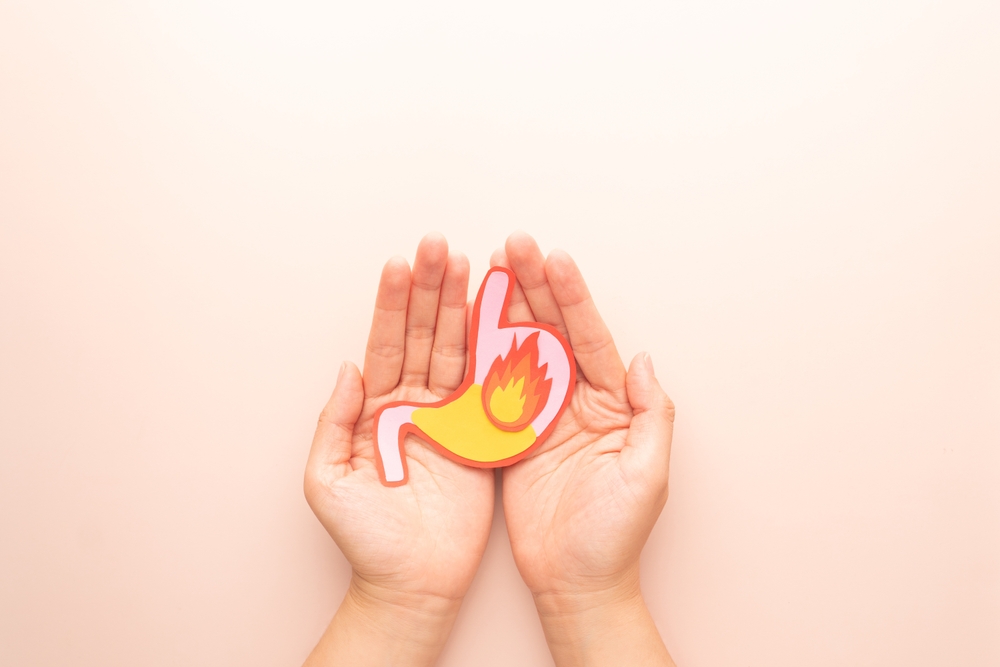If you have irritable bowel syndrome (IBS), you might already know that reflux can sometimes tag along, making things even more uncomfortable. Whether it’s after a big meal or just out of nowhere, reflux can really get in the way of feeling your best. The good news? There are a few simple, at-home strategies that can help ease those symptoms. In this article, we’ll dive into how chewing gum, practicing belly breathing, and taking a gentle post-meal walk can make a big difference in reducing reflux and helping you feel more comfortable.
This article was inspired by @thestomachdoc – a gastroenterologist on Instagram.
What is acid reflux?
Acid reflux occurs when stomach acid or bile flows back up into the esophagus (the tube connecting your mouth and stomach), leading to symptoms like heartburn, regurgitation, and chest discomfort (1). Fortunately, there are several simple strategies you can incorporate into your routine to help reduce the likelihood and severity of reflux after big meals.
Three Strategies To Reduce Reflux
1. Chewing Gum: A Simple but Powerful Remedy
Chewing gum after meals may be one of the easiest and most effective ways to combat reflux. Here’s why:
Saliva Production: Chewing gum stimulates saliva production, which serves as a natural buffer for stomach acid. Increased saliva helps neutralize acid in the esophagus, providing relief from the burning sensation caused by reflux.
Swallowing Action: Every time you swallow, the tube running between your mouth and stomach (your esophagus) is cleared of stomach acid. This action helps to prevent the acid from lingering in the esophagus, which can reduce irritation and inflammation.
Chewing gum also tricks your digestive system into thinking you are eating, which encourages both the esophagus and stomach to start clearing out food and excess acid – which then reduces the risk of food and acid coming back up the esophagus and causing symptoms.
Alkaline Effect: Some gums, especially sugar-free varieties, contain bicarbonate (a naturally occurring alkaline substance) that further helps neutralize stomach acid. Opt for a gum that’s free of peppermint, as it can sometimes relax the lower esophageal sphincter (LES), making reflux worse in some individuals.
Tip: Aim to chew gum for about 20 to 30 minutes after eating to maximize its benefits.
(Reference: Moazzez R., Bartlett D., & Anggiansah A., 2005).
FODMAP & other notes: If you are sensitive to polyols (the ‘P’ in the FODMAP acronym) then avoid chewing gums made from artificial sweeteners that end in ‘ol’ like sorbitol, xylitol, mannitol, maltitol and erythritol. Instead, you might need to try a gum made with regular sugar (make sure you brush your teeth once you’ve finished). If you struggle with bloating, then you might find the following two tips more useful as chewing gum can introduce more air into your digestive system that can contribute to bloating.
2. Belly Breathing: Relax Your Diaphragm and Soothe Your Stomach
Breathing exercises can play an important role in reducing reflux symptoms, especially when practised after a big meal. This type of breathing technique is also called diaphragmatic breathing or belly breathing.
How It Works: Belly breathing involves engaging the diaphragm rather than shallow chest breathing. By focusing on deep, slow breaths, you relax the muscles in your stomach and esophagus. This process prevents the muscles that form a valve at the top of your stomach (called the lower esophageal sphincter) from opening when it shouldn’t. Essentially, the diaphragm muscle helps close the barrier between the stomach and the esophagus which can help prevent the acid from refluxing back up
Benefits for Reflux: When you breathe deeply, it helps your body enter a more relaxed state, reducing the likelihood of acid flowing back into the esophagus. It also encourages proper digestion, as the diaphragm massage helps stimulate the digestive organs.
How to Practice Belly Breathing:
- Sit in a comfortable position.
- Place one hand on your belly and the other on your chest.
- Inhale slowly through your nose, allowing your belly to rise and expand as your diaphragm lowers.
- Exhale gently through your mouth, feeling your belly fall.
- Continue for 5 to 10 minutes, focusing on slow, deep breaths.
Doing this after a meal can calm your digestive system and help reduce any discomfort from reflux.
(Reference: Eherer et al., 2012)
Are you ready to take control of your gut symptoms?
No thanks, my gut is perfect.
3. Walking After Meals: Gentle Movement to Aid Digestion
While it may be tempting to lie down or relax after a big meal, gentle upright movement can actually help alleviate reflux symptoms. Walking after meals is a proven way to support digestion and prevent acid from backing up into the esophagus.
How It Helps: A short, leisurely walk can stimulate the digestive process by encouraging the movement of food through the stomach and intestines. Walking also helps the body maintain an upright position, which is key in keeping stomach acid where it belongs—in the stomach. When you’re upright, gravity works in your favor, reducing the chances of acid reflux.
Duration and Intensity: It’s important to keep the walk gentle and not too strenuous. A 10-15 minute stroll at a comfortable pace is ideal. Strenuous activity, such as jogging or running, can actually trigger reflux symptoms, so it’s important to avoid any intense physical exertion right after a meal.
Tip: Make sure to keep your walk slow and relaxed, and avoid hunching over, as poor posture can exacerbate reflux symptoms.
(Reference: Avidan, A, Sonnenberg, T.g. & Sontag, S.J., 2008)
Final Thoughts
Incorporating these strategies—chewing gum, belly breathing, and walking—into your post-meal routine can help reduce the discomfort associated with acid reflux, especially after big meals. These methods work together by promoting digestion, reducing acid exposure in the esophagus, and helping you stay calm and relaxed.
In addition to these strategies, it’s important to remember that making long-term lifestyle changes, such as eating smaller meals, avoiding trigger foods, and maintaining a healthy weight, can further help manage reflux symptoms. If you continue to experience frequent or severe reflux, it’s always best to consult a healthcare provider for personalized advice and treatment.
References
Image credit: Orawan Pattarawimonchai/Shutterstock.com
- Mayo Clinic. Gastroesophageal reflux disease (GERD). Mayo Clinic. Retrieved on 3 December 2024. Retrieved on: https://www.mayoclinic.org/diseases-conditions/gerd/symptoms-causes/syc-20361940
- Moazzez R, Bartlett D, Anggiansah A. (2005). The Effect of Chewing Sugar-free Gum on Gastro-esophageal Reflux. Journal of Dental Research, 84(11):1062-1065. doi:10.1177/154405910508401118
- Eherer, A J; Netolitzky, F; Högenauer, C; Puschnig, G; Hinterleitner, T A; Scheidl, S; Kraxner, W; Krejs, G J; Hoffmann, Karl Martin PD. (2021) Positive Effect of Abdominal Breathing Exercise on Gastroesophageal Reflux Disease: A Randomized, Controlled Study. American Journal of Gastroenterology 107(3):p 372-378. DOI: 10.1038/ajg.2011.420
- Avidan, B., Sonnenberg, A., Schnell, T.G. and Sontag, S.J. (2001), Walking and chewing reduce postprandial acid reflux. Alimentary Pharmacology & Therapeutics, 15: 151-155. https://doi.org/10.1046/j.1365-2036.2001.00902.x











Leave a Reply